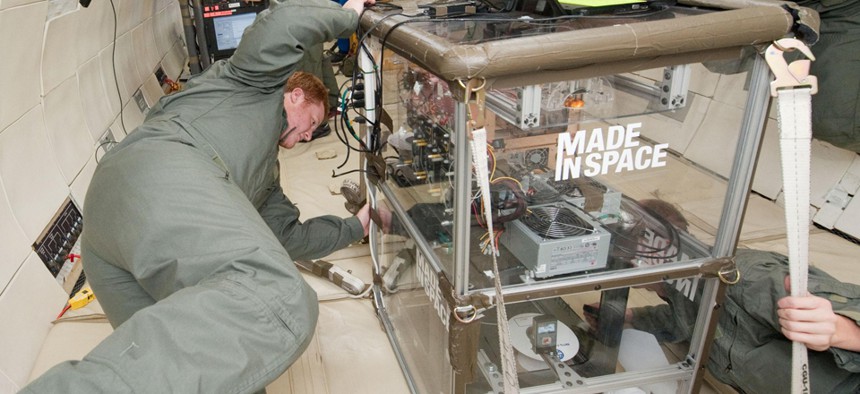Here's What It Will Take to 3-D Print Replacement Rocket Parts in Space

Two people monitoring the performance of extruders inside the Made In Space experiment box during a microgravity portion of flight aboard a modified Boeing 727 from the Zero G Corporation. Made In Space, Inc./NASA
Start with the government designing a research roadmap, NRC says.
Astronauts and robots won’t be manufacturing replacement rocket parts in space anytime soon, but space-based 3-D printing is worth researching and government should lead the way, according to a report released Friday.
“Spacecraft manufacturing is a conservative field, and private companies are reluctant to introduce advanced technologies on their own initiative,” the National Research Council report said.
Describing the technology as “in its infancy,” the report said space-based 3-D printing -- or additive manufacturing, the building of three-dimensional objects by computer -- would benefit from well-thought-out technology roadmaps and standards.
“Government plays a vital role in conducting research that can ultimately benefit civil, military and commercial satellite manufacturers,” it said.
Researchers also should make use of the International Space Station while they have it. “The ISS offers an excellent research platform for additive manufacturing work,” the report said. “But the ISS will not exist forever, and in future decades, space-based additive manufacturing will require its own infrastructure support, with its own costs.”
The aerospace industry -- frequently tasked with building complicated systems in small quantities -- already is a leader in 3-D printing. But for the most part, space-oriented 3-D printing projects in the private sector have been ground based.
The report noted 3-D printed microwave communications parts Lockheed Martin made for NASA’s Juno spacecraft, which launched in 2011 and is expected to reach Jupiter’s orbit by 2016, and the company is happy to list its numerous other space-based projects.
“While in-space additive manufacturing has an entirely new set of variables to contend with, Lockheed Martin has found encouraging success back on Earth,” the company’s spokesman Mark Lewis said.
The NRC report, which was commissioned by NASA and the Air Force, said ground-based 3-D printing projects are more likely than space-based projects to lower costs and improve space systems immediately -- but they won’t necessarily spur space-based research.
“The big difference is they can run [the objects] through rigorous testing on the ground so they know they’re going to work when they get up there,” said Dave Baiocchi, a senior engineer at RAND Corporation, who did not work on the NRC report. “And they have to work, right? We can’t go up there and futz with them if something breaks.”
Baiocchi noted transportation is one of the biggest expenses in space projects, and 3-D printing in orbit will still require materials that must be transported to space.
“Raw material weighs just as much if it’s shaped into the final form or if it just goes up as a block of raw material,” he said. “The printer itself does not solve that cost problem.”
NASA has actually considered building structures from materials found in space, such as lunar dust or Martian soil, the report noted. “But no substantial work has been done on this subject,” it said.
There are numerous environmental factors that affect 3-D printing in space and could create opportunities in the future but for now simply require study, the report said.
“The vacuum of space, zero gravity and intense thermal fluctuations all pose extreme and harsh environmental obstacles,” NRC representatives said. “These factors are important not only in terms of completing the manufacturing process but also in how they can alter the integrity of the final product.”
NASA already is the leader in space-based 3-D printing, the report noted. It is a member of the public-private 3-D printing research partnership America Makes and has numerous space-based experiments in the works; for instance, looking at how printers work in zero gravity and prospects for printing astronaut food in deep space.
The report said the government should consider research roadmaps and standards for space-based 3-D printing and suggested human spaceflight programs were more likely to see initial benefits of in-space manufacturing than robotic science missions.
NASA spokesman David E. Steitz said the agency appreciated the report’s recognition of its contributions “and our potential for continued leadership in this new space technology area.” He said NASA would take the report’s recommendations under careful review.
NEXT STORY: The Rise of the Wedding Drone



